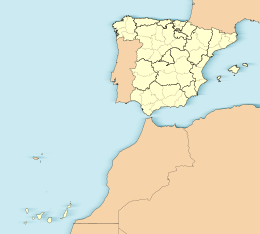Graciosa Island or commonly La Graciosa (pronounced [la ɣɾaˈsjosa]; Spanish for "graceful") is a volcanic island in the Canary Islands of Spain, located two kilometres (1+1⁄8 nautical miles) north of Lanzarote across the Strait of El Río. As the rest of the Canary Islands, it was formed by the Canary hotspot. The island is part of the Chinijo Archipelago and the Chinijo Archipelago Natural Park (Parque Natural del Archipiélago Chinijo).[4][5] It is administered by the municipality of Teguise in the neighboring island of Lanzarote. In 2018 La Graciosa was officially declared the eighth Canary Island by the Spanish Senate,[6] with few real effects.[7] Before then, the island had the status of an islet. It's administratively dependent on the island of Lanzarote.
 La Graciosa from Mirador Del Río | |
| Geography | |
|---|---|
| Location | Atlantic Ocean |
| Coordinates | 29°15′00″N 13°30′29″W / 29.250°N 13.508°W |
| Archipelago | Chinijo Archipelago, Canary Islands |
| Area | 29.05 km2 (11.22 sq mi)[1] |
| Coastline | 30.395 km (18.8866 mi)[2] |
| Highest elevation | 266 m (873 ft) |
| Highest point | Agujas Grandes |
| Administration | |
| Autonomous Community | |
| Province | Las Palmas |
| Municipality | Teguise |
| Largest settlement | Caleta de Sebo (pop. 730) |
| Demographics | |
| Population | 734 (2018)[3] |
| Pop. density | 25.27/km2 (65.45/sq mi) |
| Languages | Spanish, specifically Canarian Spanish |
| Additional information | |
| Time zone | |
| • Summer (DST) | |
The only two settlements on the island are Caleta de Sebo in the southeastern part of the island and summer-residence Casas de Pedro Barba; the rest of the island is owned by the Government of Spain and is administered by the National Parks Autonomous Agency.
The population is about 700. Tourism is the main industry along with fishing. Every year, tourists flock to the island for its tempered climate and its sandy volcanic coasts. The island has a school, lyceum, post office, supermarkets, medical center, pharmacy, a Bankia bank branch,[8] port, beaches, bar-restaurants and a square.Because of the transportation cost, everyday shopping is more expensive than in the other islands.[7]
Streets and roads on La Graciosa are unpaved sand. Motor vehicles are strictly limited to a handful of licensed vehicles for special purposes. Access to the island is by a 25-minute ferry crossing from Órzola on Lanzarote to the harbour in the village. There is a campsite on the island situated on Playa del Salado at the western edge of Caleta del Sebo.
Geographical features
The island is extremely arid and entirely made up of bushes and dry soil. Its length is 8 km (5 mi) and the width is 4 km (2+1⁄2 mi), with an area of 29 km2 (11+1⁄4 sq mi). There are no natural water sources on the island; desalinated water has been piped directly from neighbouring Lanzarote since 2001.Water supply is at risk when the pipe gets broken.[7]
There are several isolated hills on the island, the tallest of which is Agujas Grandes, rising to 266 m (873 ft). The second-tallest is Agujas Chicas at 228 m (748 ft). Playa de la Cocina is a well known beach in the southwestern part of the island.

References

- R. Pott, J. Hüppe, W. Wildpret de la Torre, Die Kanarischen Inseln. Natur- und Kulturlandschaften, Ulmer Eugen Verlag, 2003, ISBN 9783800132843





